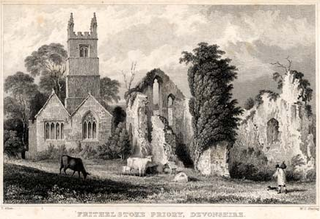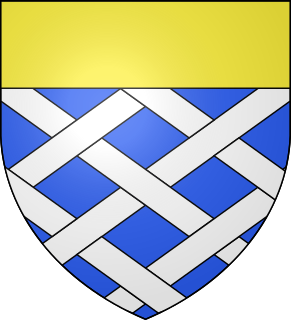

Canonsleigh Abbey was an Augustinian priory in the parish of Burlescombe, Devon.


Canonsleigh Abbey was an Augustinian priory in the parish of Burlescombe, Devon.
It was founded in about 1170 by Walter de Claville, [1] lord of the manor of Burlescombe, for the Augustinian canons regular as the Priory of the Blessed Virgin Mary and Saint John the Evangelist. He appears to have been a descendant of Walter I de Claville (floruit 1086), one of the 52 Devon Domesday Book tenants-in-chief of King William the Conqueror, who had 32 landholdings in Devon. [2] The original Anglo-Saxon name of the site donated by Walter II, perhaps a sub-manor of Burlescombe, was "Leigh" (Domesday Book Leige [3] ), which after the foundation of the Abbey became known as "Canons' Leigh" [4] and was Latinised by mediaeval scribes to Leigh Canonicorum (i.e. "Leigh of the canons"), now "Canonsleigh".
By 1284 the number of canons had declined to seven,[Declined from what figure? clarification needed ] and these were evicted in 1285 when the widow Maud de Lacy, Countess of Gloucester(d.1289), formerly the wife of Richard de Clare, 6th Earl of Gloucester (d.1262), refounded the establishment as a nunnery as the Abbey Church of the Blessed Virgin Mary, Saint John the Evangelist and Saint Etheldreda. In 1286 the abbess was granted licence to hold weekly markets. It was not especially wealthy. The number of historical records that survive for this establishment is not large which limits a full knowledge of its history. However recent research by Atkinson has added much to its known history. [5]
Among the possessions of Canonsleigh Abbey was Netherton, Farway [6]
The Abbey was suppressed in 1539 during the Dissolution of the Monasteries. Of its later history, in September 1546 Sir Richard Grenville (c.1495-1550), of Stowe, Cornwall and Bideford, and Roger Blewett of Holcombe Rogus paid nearly £1,170 for the manors of Canonsleigh in Burlescombe and Tynyell in Landulph. [7]
The remains today consist of a small 15th-century gatehouse that has two large blocked arches and, to the east, further fragments that include ruined buildings, the remains of a reredorter and a possible south wall of the eastern range of buildings. [8]

Stowe is a civil parish and former village about 2 miles (3 km) northwest of Buckingham in the unitary authority area of Buckinghamshire, England. The parish includes the hamlets of Boycott, Dadford and Lamport.

Frithelstock Priory was founded in about 1220 at Frithelstock, Devon, England, by Sir Robert de Beauchamp for Augustinian Canons Regular, as an indulgence to ensure intercessions for the repose of his soul. Walter de Stapledon, Bishop of Exeter, is considered a co-founder, for increasing the priory's endowments.

Burlescombe is a village and civil parish in the Mid Devon district of Devon, England. The parish is surrounded, clockwise from the north, by the parishes of Holcombe Rogus, Culmstock, Uffculme, Halberton and Sampford Peverell. According to the 2001 census it had a population of 911. The village is about 5 miles (8.0 km) south west of Wellington in Somerset. The ruins of the 12th century Canonsleigh Abbey are nearby. Burlescombe is part of the electoral ward of Canonsleigh. The population of this ward was 3,218 at the 2011 Census.

Knowstone is a village and civil parish situated in the North Devon district of Devon, England, halfway between the Mid Devon town of Tiverton, Devon and the North Devon town of South Molton. The hamlet of East Knowstone lies due east of the village. Knowstone was the birthplace of Admiral Sir John Berry (1635–1691), second son of Rev. Daniel Berry (1609–1654), vicar of Knowstone cum Molland. An elaborate mural monument erected by Sir John in 1684 to the memory of his parents survives in Molland Church.

Frithelstock is a village, civil parish and former manor in Devon, England. It is located within Torridge local authority area and formed part of the historic Shebbear hundred. The parish is surrounded, clockwise from the north, by the parishes of Monkleigh, Great Torrington, Little Torrington, Langtree and Buckland Brewer. In 2001 its population was 366, down from 429 in 1901.

Sir John St Leger, of Annery in the parish of Monkleigh, Devon, was an English landowner who served in local and national government.
Trentham Priory was a Christian priory in North Staffordshire, England, near the confluence between the young River Trent and two local streams, where the Trentham Estate is today.

Ranton Abbey or Ranton Priory was an Augustinian Priory in Ranton, Staffordshire, England, built c.1150 by Robert fitz Noel of Ellenhall. The priory flourished in the 13th century as a subordinate house to Haughmond Abbey. Ranton was dissolved by the Act of 1536.

Huish is a small village, civil parish and former manor in the Torridge district of Devon, England. The eastern boundary of the parish is formed by the River Torridge and the western by the Rivers Mere and Little Mere, and it is surrounded, clockwise from the north, by the parishes of Merton, Dolton, Meeth and Petrockstowe. In 2001 the population of the parish was 49, down from 76 in 1901.

Sir Thomas Grenville II, K.B.,, lord of the manors of Stowe in Kilkhampton, Cornwall and Bideford, Devon, Sheriff of Cornwall in 1481 and 1486. During the Wars of the Roses, he was a Lancastrian supporter who had taken part in the conspiracy against Richard III, organised by the Duke of Buckingham. On the accession of King Henry VII (1485–1509) to the throne, Sir Thomas was appointed one of the Esquires of the Body to Henry VII. On 14 November 1501 upon the marriage of Prince Arthur to Katherine of Aragon, he was created a Knight of the Bath. He served on the Commission of the Peace for Devon from 1510 to his death in circa 1513.

Collaton St Mary is a village, parish and former manor in Devon, England, situated about 2 miles (3 km) west of the town of Paignton. The village is bisected by the A385 Paignton to Totnes road. The parish is now administered within the unitary authority of Torbay, Devon.

The Manor of Molland was a medieval manor in North Devon, England. It was largely co-terminous with the existing parish of Molland, in which is situated the village of Molland. More accurately it consisted from the earliest times of two separate manors, held from separate overlords, later known as Molland-Bottreaux and Molland-Champson.
Walter I de Claville was an Anglo-Norman magnate and one of the 52 Devon Domesday Book tenants-in-chief of King William the Conqueror. He also held lands in Dorset. His Devonshire estates later formed part of the feudal barony of Gloucester.

The Domesday Book of 1086 lists in the following order the tenants-in-chief in Devonshire of King William the Conqueror:
The manor of Bideford in North Devon was held by the Grenville family between the 12th and 18th centuries. The full descent is as follows:

Richard Grenville lord of the manor of Stowe, Kilkhampton in Cornwall and of Bideford in Devon, was an English soldier, politician, and administrator who served as a Member of Parliament for Cornwall in 1529, and served as Sheriff of Cornwall and Sheriff of Devon.
Ralph de Pomeroy was one of the 52 Devon Domesday Book tenants-in-chief of King William the Conqueror and was the first feudal baron of Berry Pomeroy in Devon. He held 58 landholdings in Devon.

Canonteign is an historic tything in the parish of Christow, near Chudleigh, in South Devon, England and situated in the valley of the River Teign. The 'canon' in the name refers to the Augustinian canons regular, either of St Mary du Val in Normandy or of Merton Priory, which owned it for several centuries. It is best known today for the Canonteign Falls waterfall. Canonteign today contains three significant houses: the original Grade I listed 16th-century manor house, the ancient barton house situated nearby behind a granite wall, and a new mansion house built by the Pellew family in the early 19th century nearby, to which that family moved their residence thereby abandoning the old manor house.

Culm Davy is a historic manor and present-day hamlet within the parish of Hemyock in Devon.
| Wikimedia Commons has media related to Canonsleigh Abbey . |